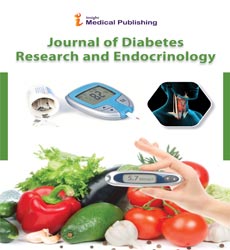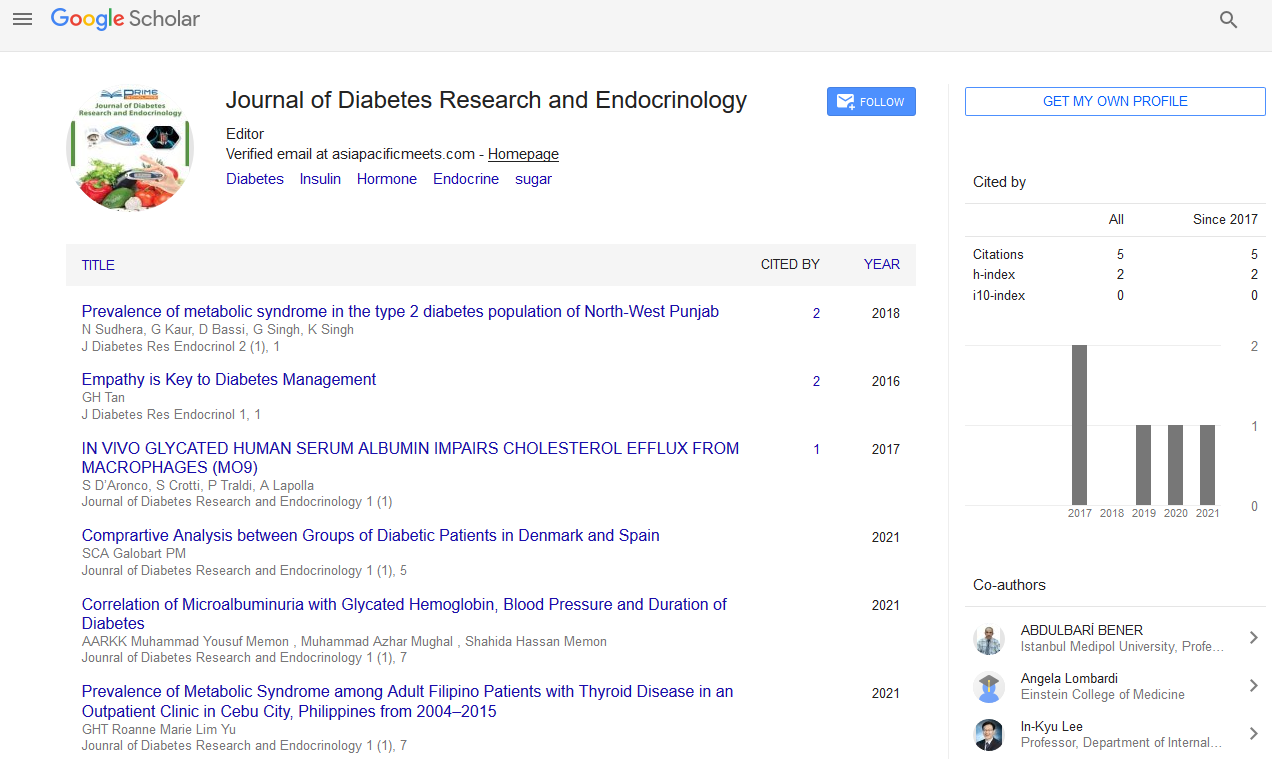Adina Bernice*
Department of Endocrinology, The University of Tennessee Health Science, Tennessee, USA
- *Corresponding Author:
- Adina Bernice
Department of Endocrinology
The University of Tennessee Health Science
Tennessee, USA
E-mail: Bernice.adina@gmail.com
Received Date: September 21, 2021; Accepted Date: October 05, 2021; Published Date: October 12, 2021
Citation: Bernice A (2021) Role of Insulin in Diabetic Patients. J Diabetes Res Endocrinol Vol.5 No.S1:001.
Description
Pancreas the source of insulin production is an essential organ
responsible for both digestion and glucose homeostasis
Historically snub, is associated with blood sugar and true enough
insulin as profound effects on carbohydrate metabolism besides
it also plays a very vital role In fat and protein metabolism
absolute or relative insulin deficiency causes diabetes mellitus
which a characterized by abnormalities in carbohydrate, protein
and fat metabolism The hormones of particular importance in
glycaemic regulation are insulin glucagon and more recently
glucagon like Peptide.
The adult human Pancreas is made up of numerous
collections of cells called islets of Langerhans. There are about
1-2 million islets and it makes, up only about 2% volume of
pancreas. While the remaining consists of blood vessels, ducts
and the larger exocrine portion of the pancreas which secrete
digestive juice and it is made up of aicini.
There are 4 major cells in the islets of Langerhans based on
staining characteristics and appearance These are as follows:
Alpha cells
Produce glucagon It increases plasma glucose by increasing
hepatic glcongenolysis and glucogenesis; increases lipolysis.
Beta cells
The majority of cells in the islets of Langerhans are beta cells,
i.e. about 60-70%. These cells release insulin, which is anabolic
in nature.
Delta cells
These cells produce somatostatin, which inhibits secretion of
insulin, pancreatic polypeptide, and glucagon by acts locally in a
paracrine manner.
F (or PP) cells
Produce pancreatic polypeptide, which slows absorption of
food, but its physiological significance, is uncertain.
The amino acid sequence of insulin molecule varies from
species to species (pigs, cows, etc). These differences will not affect the biological activity if insulin from one species is given to
another species, but they are certainly antigenic and induce
antibody formation against the injected insulin when given over
a long period of time. Human insulin is now used to avoid this
problem.
Synthesis of Insulin Insulin is synthesized in the rough
endoplasmic reticulum of the cells and it is packed into secretory
granules in the Golgi apparatus and released by an exocytosis
process. Insulin is synthesized from of amino acids which is a
single long chain called preproinsulin.This chain gets splited, i.e.
23 amino acid signal peptide is removed from it and the
remaining portion folds on itself with the formation of
disulphide bonds, to form proinsulin. The C peptide or
connecting peptide helps in the folding and connects the A and
B chains. The C peptide gets detached and insulin is formed. C
peptide level is an indicator of R cell function in patients who
receive exogenous insulin.
The alpha subunit which binds insulin is extracellular, while
the beta subunit extends from the cell membrane into the cell.
The part of the beta subunit which extends into the cell has
tyrosine kinase activity. Various factors like insulin levels,
exercise and food effects the number and affinity of insulin
receptors. A rise in insulin concentration will decreases the
number of insulin receptors called down-regulation and drop
down in insulin concentrations will increases the affinity of the
insulin receptors. The number of insulin receptors is decreased
in case of obesity and incontrast it will increased in times of
starvation.
Mechanism of action of insulin
Insulin binds to the alpha subunit of its receptor. This binding
triggers tyrosine kinase activity in the II subunit and causes auto
phosphorylation of the beta subunit. This in turn causes either
phosphorylation or dephosphorylation of certain enzymes and
proteins in the cytoplasm. Activating some and inactivating
some, thus bringing about the actions of insulin. One of the
cytoplasmic substrates for insulin action is the insulin receptor
substrate or IRS-I. Protein synthesis and growth promoting
actions of insulin are mediated through Phosphoinositol 3-
Kinase (PI3K) pathway.

